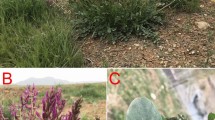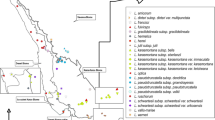Abstract
Duckweeds (Lemnaceae) are extremely reduced in morphology, which made their taxonomy a challenge for a long time. The amplified fragment length polymorphism (AFLP) marker technique was applied to solve this problem. 84 clones of the genus Lemna were investigated representing all 13 accepted Lemna species. By neighbour-joining (NJ) analysis, 10 out of these 13 species were clearly recognized: L. minor, L. obscura, L. turionifera, L. japonica, L. disperma, L. aequinoctialis, L. perpusilla, L. trisulca, L. tenera, and L. minuta. However, L. valdiviana and L. yungensis could be distinguished neither by NJ cluster analysis nor by structure analysis. Moreover, the 16 analysed clones of L. gibba were assembled into four genetically differentiated groups. Only one of these groups, which includes the standard clones 7107 (G1) and 7741 (G3), represents obviously the “true” L. gibba. At least four of the clones investigated, so far considered as L. gibba (clones 8655a, 9481, 9436b, and Tra05-L), represent evidently close relatives to L. turionifera but do not form turions under any of the conditions tested. Another group of clones (6745, 6751, and 7922) corresponds to putative hybrids and may be identical with L. parodiana, a species not accepted until now because of the difficulties of delineation on morphology alone. In conclusion, AFLP analysis offers a solid base for the identification of Lemna clones, which is particularly important in view of Lemnaceae application in biomonitoring.



Similar content being viewed by others
Abbreviations
- AFLP:
-
Amplified fragment length polymorphism
- NJ:
-
Neighbour-joining
References
Ansari AA, Khan FA (2008) Remediation of eutrophic water using Lemna minor in a controlled environment. Afr J Aquat Sci 33:275–278
Appenroth K-J (2002) Clonal differences in the formation of turions are independent of the specific turion-inducing signal in Spirodela polyrhiza (Great duckweed). Plant Biol 4:688–693
Appenroth K-J (2003) No photoperiodic control of the formation of turions in eight clones of Spirodela polyrhiza. J Plant Physiol 160:1329–1334
Appenroth K-J, Nickel G (2010) Induction of turion formation in Spirodela polyrhiza under close-to-nature conditions: the environmental signals that induce the developmental process in nature. Physiol Plant 138:312–320
Appenroth K-J, Teller S, Horn M (1996) Photophysiology of turion formation and germination in Spirodela polyrhiza. Biol Plant 38:95–106
Bänfer G, Fiala B, Weising K (2004) AFLP analysis of phylogenetic relationships among myrmecophytic species of Macaranga (Euphorbiaceae) and their allies. Plant Syst Evol 249:213–231
Baumbach H, Hellwig FH (2007) Genetic differentiation of metallicolous and non-metallicolous Armeria maritima (Mill.) Willd. taxa (Plumbaginaceae) in Central Europe. Plant Syst Evol 269:245–258
Bergmann BA, Cheng J, Classen J, Stomp AM (2000) Nutrient removal from swine lagoon effluent by duckweed. Trans ASAE 43:263–269
Bonin A, Ehrich D, Manel S (2007) Statistical analysis of amplified fragment length polymorphism data: a toolbox for molecular ecologists and evolutionists. Mol Ecol 16:3737–3758
Booij-James IS, Edelman M, Mattoo AK (2009) Nitric oxide donor-mediated inhibition of phosphorylation shows that light-mediated degradation of photosystem II D1 protein and phosphorylation are not tightly linked. Planta 229:1347–1352
Brain RA, Solomon KR (2007) A protocol for conducting 7-day renewal test with Lemna gibba. Nat Protoc 2:979–987
Cabrera LI, Salazar GA, Chase MW, Mayo SJ, Bogner J, Davila P (2008) Phylogenetic relationships of Aroids and duckweeds (Araceae) inferred from coding and noncoding plastid DNA. Am J Bot 95:1153–1165
Cayuela ML, Millner P, Slovin J, Roig A (2007) Duckweed (Lemna gibba) growth inhibition bioassay for evaluating the toxicity of olive mill wastes before and during composting. Chemosphere 68:1985–1991
Chaiprapat S, Cheng JJ, Classen JJ, Liehr SK (2005) Role of internal nutrient storage in duckweed growth for swine wastewater treatment. Trans ASAE 48:2247–2258
Crawford DJ, Landolt E, Les DH (1996) An allozyme study of two sibling species of Lemna (Lemnaceae) with comments on their morphology, ecology and distribution. Bull Torrey Club 123:1–5
Crawford DJ, Landolt E, Les DH, Tepe E (1997) Allozyme variation and the taxonomy of Wolffiella. Aquat Bot 58:43–54
Crawford DJ, Landolt E, Les DH, Kimball RT (2001) Allozyme studies in Lemnaceae: variation and relationships in Lemna sections Alatae and Biformes. Taxon 50:987–999
Crawford DJ, Landolt E, Les DH, Archibald JK, Kimball RT (2005) Allozyme variation within and divergence between Lemna gibba and L. disperma: systematic and biogeographic implications. Aquat Bot 83:119–128
De Lange L (1975) Gibbosity in the complex Lemna gibba/Lemna minor: literature survey and ecological aspects. Aquat Bot 1:327–332
Despres L, Gielly L, Redoutet B, Taberlet P (2003) Using AFLP to resolve phylogenetic relationships in a morphologically diversified plant species complex when nuclear and chloroplast sequences fail to reveal variability. Mol Phyl Evol 27:185–196
Dudley JL (1987) Turion formation in strains of Lemna minor (6591) and Lemna turionifera (6573,A). Aquat Bot 27:207–215
Dumortier BCJ (1827) Florula belgica, operis majoris prodromus auctore. B.-C. Dumortier. Staminacia. J. Casterman, Tournay
Falush D, Stephens M, Pritchard JK (2007) Inference of population structure using multilocus genotype data: dominant markers and null alleles. Mol Ecol Notes 7:574–578
Ferdoushi Z, Haque F, Khan S, Haque M (2008) The Effects of two aquatic floating macrophytes (Lemna and Azolla) as biofilters of nitrogen and phosphate in fish ponds. Turk J Fish Aquat Sci 8:253–258
Gemeinholzer B, Bachmann K (2005) Examining morphological and molecular diagnostic character states of Cichorium intybus L. (Asteraceae) and C. spinosum L. Plant Syst Evol 253:105–123
Giardelli ML (1937) Una nueva especie de Lemnacea de la Flora Argentina. Notas del Museo de la plata 2. Botanica 12:97–100
Giuga G (1973) Vita segreta di Lemnacee. Lemna symmeter G. Giuga—species nova. Blario, Napoli
Greilhuber J, Borsch T, Müller K, Worberg A, Porembski S, Barthlott W (2006) Smallest angiosperm genomes found in Lentibulariaceae, with chromosomes of bacterial size. Plant Biol 8:770–777
Hegelmaier F (1868) Die Lemnaceen. Eine Monographische Untersuchung. Engelmann, Leipzig
Hellwig F, Nolte M, Ochsmann J, Wissemann V (1999) Rapid isolation of total cell DNA from milligram plant tissue. Haussknechtia 7:29–34
Jansen MAK, Gaba V, Greenberg BM, Mattoo AK, Edelman M (1996) Low threshold levels of ultraviolet-B in a background of photosynthetically active radiation trigger rapid degradation of the D2 protein of photosystem II. Plant J 9:693–699
Jordan WC, Courtney MW, Neigel JE (1996) Low levels of intraspecific genetic variation at a rapid evolving chloroplast DNA locus in North American duckweeds (Lemnaceae). Am J Bot 83:430–439
Kandeler R (1975) Species delimitation in the genus Lemna. Aquat Bot 1:365–376
Kandeler R, Hügel B (1974) Wiederentdeckung der echten Lemna perpusilla Torr. und Vergleich mit L. paucicostata Hegelm. Plant Syst Evol 123:83–96
Landolt E (1975) Morphological differentiation and geographical distribution of the Lemna gibba–Lemna minor group. Aquat Bot 1:345–363
Landolt E (1986) The family of Lemnaceae—a monographic study, vol. 1. Biosystematic investigations in the family of duckweeds (Lemnaceae). Veröffentlichungen des Geobotanischen Institutes der ETH, Stiftung Rübel, Zürich
Landolt E (1998) Lemna yungensis, a new duckweed species from rocks of the Andean Yungas in Bolivia. Bull Geobot ETH Zuerich 64:15–21
Landolt E (2000) Contribution on the Lemnaceae of Ecuador. Fragm Flor Gebot 45:221–237
Lara-Cabrera SL, Spooner DM (2004) Taxonomy of North and Central American diploid wild potato (Solanum sect. Petota) species: AFLP data. Plant System Evol 248:129–142
Lemon GD, Posluszny U (2000) Comparative shoot development and evolution in the Lemnaceae. Int J Plant Sci 161:733–748
Les DH, Crawford DJ (1999) Landoltia (Lemnaceae), a new genus of duckweeds. Novon 9:530–533
Les DH, Landolt E, Crawford DJ (1997) Systematics of the Lemnaceae (duckweeds): inferences from micromolecular and morphological data. Plant Syst Evol 204:161–177
Les DH, Crawford DJ, Landolt E, Gabel JD, Kimball RT (2002) Phylogeny and systematics of Lemnaceae, the duckweed family. Syst Bot 27:221–240
Li J, Jain M, Vunsh R, Vishnevetsky J, Hanania U, Flaishman M, Perl A, Edelman M (2004) Callus induction and regeneration in Spirodela and Lemna. Plant Cell Rep 22:457–464
Mardanov AV, Ravin NV, Kuznetsov BB, Samigullin TH, Antonov AS, Kolganova TV, Skyabin KG (2008) Complete sequence of the duckweeds (Lemna minor) chloroplast genome: structural organization and phylogenetic relationships to other angiosperms. J Mol Evol 66:555–564
Martirosyan EV, Ryzhova NN, Skryabin KG, Kochieva EZ (2008) RAPD analysis of genome polymorphism in the family Lemnaceae. Russ J Genetics 44:360–364
Martirosyan EV, Ryzhova NN, Kochieva EZ, Skryabin KG (2009) Analysis of chloroplast rpS16 intron sequences in Lemnaceae. Mol Biol 43:32–38
Meudt HM, Clarke AC (2007) Almost forgotten or latest practice? AFLP applications, analyses and advances. Trends Plant Sci 12:106–117
Naumann B, Eberius M, Appenroth K-J (2007) Growth rate based dose-response relationships and EC-values of ten heavy metals using the duckweed growth inhibition test (ISO 20079) with Lemna minor L. clone St. J Plant Physiol 164:1656–1670
Nei M, Li W-H (1979) Mathematical model for studying genetic variation in terms of restriction endonucleases. Proc Natl Acad Sci USA 76:5269–5273
Pritchard JK, Stephens M, Donelly P (2000) Inference of population structure using multilocus genotype data. Genetics 155:945–959
Rapparini F, Cohen JD, Slovin JP (1999) Indol-3-acetic acid biosynthesis in Lemna gibba studies using stable isotope labelled anthranilate and tryptophan. Plant Growth Regul 27:139–144
Reimann R, Ziegler P, Appenroth K-J (2007) The binding of alpha-amylase to starch plays a decisive role in the initiation of storage starch degradation in turions of Spirodela polyrhiza. Physiol Plant 129:334–341
Rival S, Wisniewski JP, Langlais A, Kaplan H, Freyssinet G, Vancanneyt G, Vunsh R, Perl A, Edelman M (2008) Spirodela (duckweed) as an alternative production system for pharmaceuticals: a case study, aprotinin. Transgenic Res 17:503–513
Rothwell GW, Van Atta MR, Ballard HE, Stockey RA (2004) Molecular phylogenetic relationships among Lemnaceae and Araceae using the chloroplast trnL–trnF intergenic spacer. Mol Phyl Evol 30:378–385
Van de Peer Y, De Wachter R (1994) TREECON for Windows: a software package for the construction and drawing of evolutionary trees for the Microsoft Windows environment. Comp Appl Biosci 10:569–570
Vaughan D, Baker RG (1994) Influence of nutrients on the development of gibbosity in fronds of the duckweed Lemna gibba L. J Exp Bot 45:129–133
Vos P, Hogers R, Bleeker M, Reijans M, Van de Lee T, Hornes M, Frijters A, Pot J, Peleman J, Kuiper M, Zabenau M (1995) AFLP: a new technique for DNA fingerprinting. Nucleic Acids Res 23:4407–4414
Vunsh R, Li JH, Hanania U, Edelman M, Flaishman M, Perl A, Wisniewski JP, Freyssinet G (2007) High expression of transgene protein in Spirodela. Plant Cell Rep 26:1511–1519
Yamamoto YT, Rajbhandari N, Lin X, Germann BA, Nishimura Y, Stomp A-M (2001) Genetic transformation of duckweed Lemna gibba and Lemna minor. In Vitro Cell Dev Biol Plant 37:349–353
Acknowledgments
We thank Prof. Eric Lam, Rutgers University, NJ for critical comments and the German Research Foundation, Bonn, Germany for supporting this project (AP 54/10-1).
Author information
Authors and Affiliations
Corresponding author
Additional information
The contributions of M. Bog and H. Baumbach are considered to be equal.
Electronic supplementary material
Below is the link to the electronic supplementary material.
Rights and permissions
About this article
Cite this article
Bog, M., Baumbach, H., Schween, U. et al. Genetic structure of the genus Lemna L. (Lemnaceae) as revealed by amplified fragment length polymorphism. Planta 232, 609–619 (2010). https://doi.org/10.1007/s00425-010-1201-2
Received:
Accepted:
Published:
Issue Date:
DOI: https://doi.org/10.1007/s00425-010-1201-2




